Posted: May 23rd, 2017 | No Comments »
This is a Chinese proverb, printed on a small piece of rolled paper and inserted in a 1930s Tom Smith English Christmas cracker….not sure how authentic it is though?
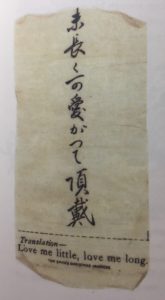
Posted: May 21st, 2017 | No Comments »
“Time there seemed to pass differently. When you are shut off from the world, every day is exactly the same as the one before. This sameness has a way of wearing down your soul until you become nothing but a breathing, toiling, consuming thing that awakes to the sun and sleeps at the dawning of the dark. The emptiness runs deep, deeper with each slowing day, and you become increasingly invisible and inconsequential. That’s how I felt at times, a tiny insect circling itself, only to continue, and continue. There, in that relentless vacuum, nothing moved. No news came in or out. No phone calls to or from anyone. No emails, no letters, no ideas not prescribed by the regime. Thirty missionaries disguised as teachers and 270 male North Korean students and me, the sole writer disguised as a missionary disguised as a teacher. Locked in that prison disguised as a campus in an empty Pyongyang suburb, heavily guarded around the clock, all we had was one another.â€
An excerpt from the Preface of Without You There Is No Us: Undercover Among the Sons of North Korea’s Elite by Suki Kim, published by Crown Publishing Group, 2014.
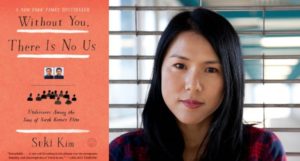
On Wednesday 24th May, sponsored by Cockayne Grants for the Arts, a donor-advised fund of the London Community Foundation, we will be welcoming investigative journalist Suki Kim to our talk, Undercover in Pyongyang. Kim will be in conversation with Paul French, author of North Korea: State of Paranoia to discuss vice and virtue in Pyongyang. Â
Suki Kim covered North Korea for a decade and lived undercover for six months in Pyongyang in 2011, the final year of Kim Jong-il’s regime. Her observations and investigations as a missionary and a teacher at the all-male Pyongyang University of Science and Technology (PUST) resulted in her New York Times Bestselling non-fiction title, Without You There Is No Us: Undercover Among the Sons of North Korea’s Elite which offers a rare glimpse of life into the world’s most unknowable country.
To book tickets for this event, please click here.
General: £10, Concessions: £8, Asia House Arts Members: £5
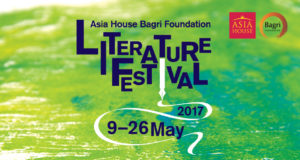
Posted: May 20th, 2017 | 5 Comments »
The Little Shop traded from the notoriously louche Kiangse Road (Jiangxi Road), on the corner of Ezra Road (now Shashi Road No.2), not far from the upscale bordellos down closer to the Soochow Creek – do click on the ad (from 1930) below to enlarge. Technically the store’s address was No.5 Ezra Road though that building actually connected through the corner to No.30 Kiangse Road. As you can see The Little Shop specialised in all the usual categories of curios and antiques – it was not as well known as its competitors on Nanking Road clustered by the Cathay Hotel (Grays Yellow Lantern store and Hoggard-Sigler for instance) but was in business for quite some time. The proprietor was Mrs E. Boyd and the store’s hong name was Shang hai koo wan shih. The earliest back I can trace the store trading is the mid-1920s.
As to Mrs. Boyd I’m afraid I’m sadly lacking on information. There was a Boyd family that was well established in Shanghai in the shipbuilding and dry dock business but I don’t know if there was any familial connection. There was also an Edyth Boyd who was very involved in the American Presbyterian Mission around the same time period. Bit more digging around to do here….

Posted: May 19th, 2017 | No Comments »
Lawrence Paterson’s new history of German submarine warfare in WW2 in the Far East…
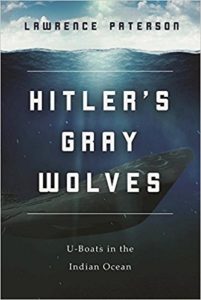
Next to nothing has been written about the U-boat war in the Indian Ocean. This is the story of a forgotten campaign. The battle began in August 1943, when a German submarine arrived in the Malaysian harbor of Georgetown. In total, nearly forty U-boats were assigned to penetrate the Indian Ocean, serving alongside troops of the occupying Imperial Japanese forces.
The Japanese allowed U-boats to use Malaysia as an operational station. From that base, they mixed with Japanese forces on a hitherto unseen scale: a move which spread the U-boat war throughout the vast Indian Ocean and into the Pacific. Success in this theater of war held a real chance to swing the tide of battle in North Africa in favor of Rommel, but the Germans essentially did too little too late.
The joint action also gave U-boats the opportunity to penetrate the Pacific Ocean for the first time, attacking shipping off the Australian coast and hunting off New Zealand. Plans were even afoot for an assault on American supply lines. The cooperation’ also brought into stark relief the fundamental differences of German and Japanese war aims. After the crews of Italian supply submarines joined the Germans and Japanese, relations between the fighting men of the three main Axis powers were often brutal and almost constantly turbulent.
Stories of U-boats laden with gold and treasure stem almost exclusively from boats destined to and returning from Japanese-controlled Malaysia, laden with material exchanged between the two major partners of the Triple Axis Alliance.
Posted: May 18th, 2017 | No Comments »
I don’t always note North Korea-related events I’m involved with on this blog – but this should be an interesting one given the times!
YCW London: Turning point in China-North Korea Relations? (22nd May, Monday, 7.00Â pm, at RUSI)
with Andrea Berger, Senior Research Associate at the James Martin Center for Nonproliferation Studies, and Paul French, author of “North Korea: State of Paranoia”
RSVP here
Monday, May 22, 2017, 7:00 pm
RUSI, 61 Whitehall, London SW1A 2ET
[6:30 pm] Doors Open [7:00 pm] Event Begins

In China, ties with North Korea have traditionally been referred to as “close as lips and teeth.†But with North Korea recently dropping the word “friendly” in describing China as “neighbour”, tension between the two allies is building.
Beijing has grown increasingly frustrated at North Korea’s actions, which in recent months includes pushing ahead with a nuclear programme, stating it is “ready” to sink a US aircraft Carrier, staging a grandiose military parade in commemoration of founding father Kim Il-sung, and assassinating Kim Jong Un’s brother Kim Jong Nam. Reflecting its growing discomfort, in 2016, China agreed to sanction North Korea in the UN Security Council and also rejected its coal exports. More recently, though, China has invited North Korea to its Silk Road Summit.
For its part, South Korea could advocate a softer stance toward Pyongyang and Beijing under new President, Moon Jae In, who may also reevaluate the US THAAD missile shield program.
US President Donald Trump’s military response in Syria adds to the complexity, though as he learned fom a 10-minute crash course by Chinese President Xi Jinping, “It’s not so easy.”
What are the driving factors in the China-North Korea relationship and what is its future?
Andrea Berger is a London-based Senior Research Associate at the James Martin Center for Nonproliferation Studies, where she focuses on East Asian nuclear issues, export control and sanctions, and proliferation finance. Andrea is also a contributor to the Arms Control Wonk blog and a co-host of the Arms Control Wonk podcast.
Between 2012-2015, she led Track 1.5 security talks with the North Korean People’s Army and Worker’s Party in Pyongyang and London. Prior to joining CNS, Andrea was the Deputy Director of the Proliferation and Nuclear Policy team at the Royal United Services Institute (RUSI), and directed the UK’s network of next-generation nuclear professionals. She also worked for the Government of Canada in a number of analytical capacities, lastly in Global Affairs Canada.
Andrea holds a BA (Hons) in Political Science from Carleton University and an MA in International Peace and Security from King’s College London.
|
|
|
|
|
Paul French is an author and journalist specialising in China and North Korea. His history of the DPRK – North Korea State of Paranoia – was first published in 2004 and has been constantly updated and reissued ever since. He is also the author of the e-book Our Supreme Leader: The Making of Kim Jong-un.
French lived in China for many years and first visited the DPRK in 2002. French appears regularly to commentate on the DPRK on BBC TV and radio, Channel 4 News and via op-eds in the Washington Post and Reuters among others.
|
|
|
|
|
Address: 61 Whitehall, London SW1A 2ET.
Library at RUSI
|
|
|
|
|
|
Posted: May 17th, 2017 | No Comments »
The Dollar Line offered steamships from Los Angeles around the world – but, in 1929, their biggest office outside the USA was on the Shanghai Bund – hence, I can only assume, the subliminal advertising image of a pagoda….
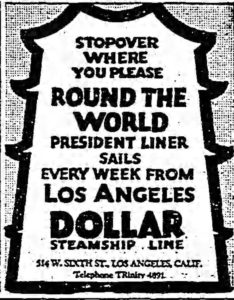
Posted: May 16th, 2017 | No Comments »
To note the re-publication of Whitey Smith’s fantastic I Didn’t Make a Million by Earnshaw Books…
Thursday, 18th May 2017
7:00 pm – 8:15 pm
Wooden Box
Whitey Smith in Shanghai’s Jazz Age: The Man Who Taught China to Dance
Speaker: Andrew Field and Graham Earnshaw
JOINT EVENT The Hopkins China Forum and RAS

18:45 – Doors Open
19:00 – Lecture
19:45 – Q&A
20:15 – Mixer/Drinks/Dinner
21:00 – Live music at the Wooden Box
Whitey Smith was one of the earliest American jazz musicians to play in Shanghai, and one of the most loved jazz musicians in China between the 1920s and 1930s, as both his own book and many other records from the era attest. In tonight’s talk, we re-launch his memoirs with the publisher and one of the world’s experts on Shanghai in the jazz age and author of the introduction.
Andrew Field is Associate Dean at Duke Kunshan University and scholar of Chinese literature and culture. In addition to Mu Shiying: China’s Lost Modernist (2014), he wrote Shanghai’s Dancing World: Cabaret Culture and Urban Politics, 1919-1954 (2010) and is the co-author of Shanghai Nightscapes: A Nocturnal Biography of a Global City (2015). Field has taught East Asian History at the University of Puget Sound, and was Lecturer in Chinese History at the University of South Wales. In addition to these recent books, he was also recently co-producer of the film, Down: Indie Rock in the PRC. Field holds a PhD in East Asian Languages and Civilizations from Columbia University.
Graham Earnshaw is a publisher and writer with several decades of experience in the China world. He is publisher of Earnshaw Books and China Economic Review, and CEO of SinoMedia Ltd. He has written a number of books himself, including On Your Own in China (1984), Tales of Old Shanghai (2008) and an account of his continuing walk across China, The Great Walk of China (2010), and translated the Jin Yong Kung-Fu novel The Book and the Sword (2008). He has lived in the China world almost continuously since the mid-1970s and is a regular speaker at universities, schools, and businesses. He speaks Mandarin and Cantonese fluently, and his English is said to be acceptable.
About Hopkins China Forum: Hopkins China Forum events are organized under the auspices of The Johns Hopkins University and its affiliated alumni associations worldwide. For more information on Hopkins events in Shanghai, please contact Frank Tsai at the Johns Hopkins University Alumni Association – Shanghai at editor@shanghai-review.org.
RSVP to Frank Tsai of Hopkins China Forum : editor@shanghai-review.org
ENTRANCE: Admission: 50 RMB
VENUE: Wooden Box; 9 Qinghai Lu (just to the South of Nanjing West Road) é’æµ·è·¯ 9 å·, è¿‘å—京西路, 地é“二å·çº¿å—京西路站 Shanghai
Posted: May 15th, 2017 | 1 Comment »
I’m no demographer but I’m betting Yanks outnumber Portuguese and Swiss in Shanghai these days….











